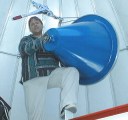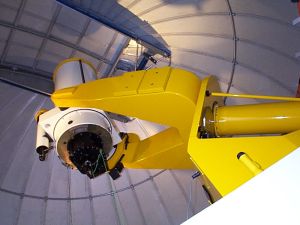
| SDSS Classic |
| SDSS.org |
| SDSS4.org |
| SDSS3.org |
| SDSS Data |
| DR19 |
| DR17 |
| DR10 |
| DR7 |
| Science |
| Press Releases |
| Education |
| Image Gallery |
| Legacy Survey |
| SEGUE |
| Supernova Survey |
| Collaboration |
| Publications |
| Contact Us |
| Search |

The history of the photometric telescope
Sloan Digital Sky Survey's two telescopes are designed to work together as a team, although it is a partnership of unequals. The dominant team member is the 2.5-meter telescope, meticulously planned and built by the SDSS collaboration. This instrument, from its innovative wind baffle to its huge mosaic camera, was born and bred for its task of methodically surveying 100 million objects in the heavens.
The second telescope, by comparison, is the junior partner. Its less glamorous job is to automatically observe many standard star fields each clear night during the survey in order to calibrate the data from the main telescope. By performing this time-consuming yet crucial chore, the telescope gives its larger companion the freedom to efficiently scan the skies without interruption. The Sky Survey collaborators, desiring a moderately priced, low-maintenance automated instrument, originally purchased a 0.6-meter monitor telescope for $200,000 from a company purporting to specialize in such telescopes.
But while the 2.5-meter telescope successfully demonstrated its surveying prowess, the monitor telescope was plagued with problems. "Incorrect materials and poor design doomed it from the beginning," said Alan Uomoto of Johns Hopkins University. "The result was a telescope that did not meet performance requirements and had a short projected lifetime."
 In 1997, Sky Survey
collaborators decided that the monitor telescope could jeopardize the survey's
goals. After careful consideration of several alternatives, the SDSS team decided to replace the
entire monitor telescope with an existing 0.5-meter telescope from the roof of the
astronomy building at Johns Hopkins. In August 1998, the faulty telescope was
disassembled (as seen at left), and its replacement was lowered into the
dome at Apache Point.
In 1997, Sky Survey
collaborators decided that the monitor telescope could jeopardize the survey's
goals. After careful consideration of several alternatives, the SDSS team decided to replace the
entire monitor telescope with an existing 0.5-meter telescope from the roof of the
astronomy building at Johns Hopkins. In August 1998, the faulty telescope was
disassembled (as seen at left), and its replacement was lowered into the
dome at Apache Point.
 The successor, christened the photometric telescope (at right), required some modifications to the dome and the instrument package. A human observer remained on hand for two years to ensure that the data-taking proceeded
smoothly. With a proven track record at Johns Hopkins, however, the photometric telescope soon demonstrated itself a worthy partner to the 2.5-meter.
The successor, christened the photometric telescope (at right), required some modifications to the dome and the instrument package. A human observer remained on hand for two years to ensure that the data-taking proceeded
smoothly. With a proven track record at Johns Hopkins, however, the photometric telescope soon demonstrated itself a worthy partner to the 2.5-meter.
Photo credits: Gretchen Van Doren and Mark Klaene (APO)